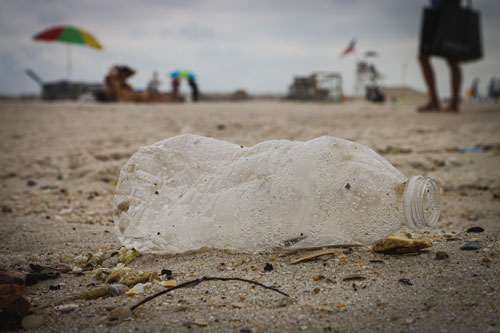Turns out, much of the water found on Earth is contaminated with microplastics. It’s quite possible that microplastics are in both your tap water and any bottled water you consume. This has created a lot of concern as many people are now worried that microplastics could have a bad impact on the environment and our health.
Plastics don’t readily degrade. Instead, they break down into smaller and smaller particles. That plastic wrapper floating in a river could one day become trillions of tiny plastic nanoparticles. This is how microplastics are created.
We use a lot of plastic. Each year, hundreds of millions of tons of plastics are produced. Unfortunately, some of that plastic ends up contaminating the environment, affecting our drinking water supplies, groundwater, and more. And as that plastic breaks down into smaller particles, it contaminates our water with microplastics.
Microplastics are now very widespread. Some believed that the average person could be consuming 5 grams or more of microplastics per week. To put that into perspective, 5 grams of plastic is roughly equal to a credit card. Yet we’re not exactly sure what effects microplastics have on our health and body.

The Health Impacts of Microplastics
For now, we’re not sure what the health impacts of microplastics are. As the director of the Department of Public Health, Environment, and Social Determinants of Health at the World Health Organization (WHO) Dr. Maria Neira says “We urgently need to know more about the health impact of microplastics because they are everywhere — including in our drinking water.”
The WHO believes that microplastics could impact our health in one of three ways:
- Chemical– Plastics are contaminated with dangerous chemicals and then absorbed into our body, these chemicals could pose a threat.
- Physical– The plastic particles themselves could accumulate and damage organs and other internal structures. There is some evidence that tiny microplastic particles could pass through your stomach wall and enter your bloodstream.
- Biofilm– It’s possible that microplastics will become breeding grounds for pathogens, such as bacteria.
However, we’re still not exactly how big of a threat microplastics are. Researchers have found evidence that our body does consume microplastics. We also know that microplastics are widespread and frequently found in drinking water. Yet the health impact remains unknown. For your protection, our fill station is available to provide you and your family with pure and microplastic-free water.

Microplastics: An Unknown Risk
We’ve only just recently recognized the potential risk posed by microplastics in our drinking water. We’ll need to study them more closely and thoroughly before any conclusive answer is reached. Funding for and interest in microplastics research has been limited up until recent years.
In the future, as more research is conducted, we’ll learn more about whether microplastics pose any threat or health risks. Keep in mind, however, that we often only learn about the dangers posed by certain materials long after their use or presence becomes widespread.
Take asbestos, for example. This material was a preferred building material for many years until we realized that it was carcinogenic. Or lead, a dangerous metal and common water contaminant that was actually once used for piping and in paint! We now know that these materials are quite dangerous.
We may find out later on that microplastics do indeed pose a major threat. Or maybe we’ll discover that they are relatively harmless. It’s hard to say.
For now, it’s a safer bet to remove microplastics from your water. You can do this with a reverse osmosis filtration system, which should successfully remove most microplastic particles from your drinking water.
Worried about microplastics? Get in touch with Atlantic Blue Water Center. We have water treatment solutions that will
be able to remove microplastics from your water.
